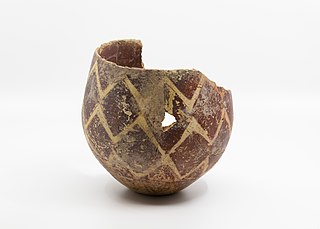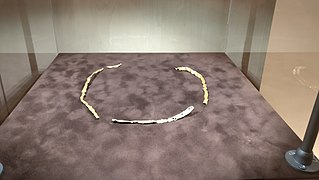
The Kura–Araxes culture was an archaeological culture that existed from about 4000 BC until about 2000 BC, which has traditionally been regarded as the date of its end; in some locations it may have disappeared as early as 2600 or 2700 BC. The earliest evidence for this culture is found on the Ararat plain; it spread north in the Caucasus by 3000 BC.

The Maykop culture, c. 3700 BC–3000 BC, was a major Bronze Age archaeological culture in the western Caucasus region.

Melid, also known as Arslantepe, was an ancient city on the Tohma River, a tributary of the upper Euphrates rising in the Taurus Mountains. It has been identified with the modern archaeological site of Arslantepe near Malatya, Turkey.

The Shulaveri–Shomu culture, also known as the Shulaveri-Shomutepe-Aratashen culture, is an archaeological culture that existed on the territory of present-day Georgia, Azerbaijan, and Armenia, as well as parts of northern Iran during the Late Neolithic/Eneolithic. It lasted from around the end of the seventh millennium BC to the beginning of the fifth millennium BC.

Godin Tepe is an archaeological site in western Iran, located in the valley of Kangavar in Kermanshah Province. Discovered in 1961, the site was excavated from 1965 to 1973 by a Canadian expedition headed by T. Cuyler Young Jr. and sponsored by the Royal Ontario Museum. The importance of the site may have been due to its role as a trading outpost in the early Mesopotamian trade networks.

In the archaeology of Southwest Asia, the Late Neolithic, also known as the Ceramic Neolithic or Pottery Neolithic, is the final part of the Neolithic period, following on from the Pre-Pottery Neolithic and preceding the Chalcolithic. It is sometimes further divided into Pottery Neolithic A (PNA) and Pottery Neolithic B (PNB) phases.
Aratashen is a town in the Armavir Province of Armenia. It is located on the Ararat plain.
Böyük Kəsik is a village and municipality in the Agstafa Rayon of Azerbaijan. It has a population of 1,791.

Kültəpə is a settlement dating from the Neolithic Age, a village and municipality in the Babek District of Nakhchivan, Azerbaijan. It has a population of 1,859.
Ərəbyengicə is a village and municipality in the Sharur District of Nakhchivan Autonomous Republic, Azerbaijan. It is located 12 km in the south from the district center, on the left bank of the Arpachay River. Its population is busy with farming and animal husbandry. There are secondary school, club and a medical center in the village. It has a population of 894.
Choghā Mīsh (Persian language; چغامیش čoġā mīš) dating back to about 6800 BC, is the site of a Chalcolithic settlement located in the Khuzistan Province Iran on the eastern Susiana Plain. It was occupied at the beginning of 6800 BC and continuously from the Neolithic up to the Proto-Literate period, thus spanning the time periods from Archaic through Proto-Elamite period. After the decline of the site about 4400 BC, the nearby Susa, on the western Susiana Plain, became culturally dominant in this area. Chogha Mish is located just to the east of Dez River, and about 25 kilometers to the east from the ancient Susa. The similar, though much smaller site of Chogha Bonut lies six kilometers to the west.

The Leyla-Tepe culture of the South Caucasus belongs to the Chalcolithic era. It got its name from the site in the Agdam district of modern day Azerbaijan. Its settlements were distributed on the southern slopes of Central Caucasus, from 4350 until 4000 B.C.
Kul Tepe Jolfa is an ancient archaeological site in the Jolfa County of Iran, located in the city of Hadishahr, about 10 km south from the Araxes River.

Dalma culture was a prehistoric archaeological culture of north-western Iran dating to early fifth millennium B.C. Later, it spread into the central Zagros region and elsewhere in adjacent areas. Its widespread ceramic remains were excavated in central and northern valleys of the Zagros Mountains in north-western Iran. Dalma assemblages were initially discovered by the excavations carried out at Dalma Tepe and Hasanlu Tepe in south-western parts of Lake Urmia, in the valley of Solduz.
Osmantəpə is an early Neolithic settlement near Kükü village, in the Shahbuz District of the Nakhchivan Autonomous Republic of Azerbaijan.
Uçan ağıl is an archaeological site north of Sirab village in Babek District of Nakhchivan Autonomous Republic, Azerbaijan. It is located at the altitude of 1200 m a.s.l. in the Sirab piedmonts, in the upper reaches of Sirab Suyu river along with other sites from the same period, Sorsu, and Zirinclik. It is dated at ca 4850-4350 BC time span, but was also occupied in the 3rd millennium BC. Uçan Ağıl was likely used by mobile pastoralists on a seasonal basis. They mostly pastured herds of goats.

Ovçular Tepesi is an ancient settlement located at the northern end of Dizə, Sharur village in Sharur District of Azerbaijan, on the left bank of Arpa (river). It dates back to the fifth millennium BC, and continued to the third millenniums BC.
Hirbemerdon Tepe is an archaeological site in Turkey located in the east of Diyarbakir Province, on the western bank of the Tigris River, 40 kilometers east of Bismil, Turkey. The settlement began in the fourth millennium BCE during the Chalcolithic era, and continued to the time of the Ottoman Empire. The earliest pottery at the site is similar to the chaff-faced ware of Uruk period.

Godedzor is a prehistorical archaeological site located about 1,5 kilometres west of the village of Angeghakot in the Syunik Province of Armenia. The settlement of Nerkin Godedzor is in the Vorotan river gorge, at the altitude of 1800 meters. Some petroglyphs are also found close by.
Galayeri is an important archaeological site of the Chalcolithic era located in the Qabala District of Azerbaijan. It belongs to the Leyla-Tepe culture.











